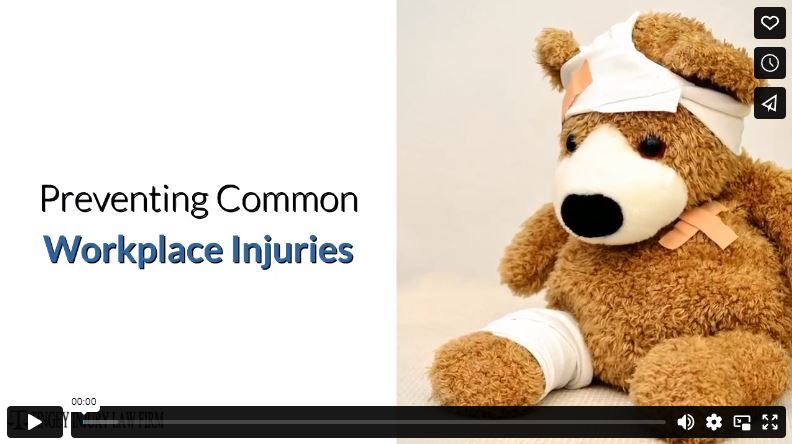Have you been injured on the job? If so, you’re in good company. According to the National Safety Council, a worker is injured on the job every 7 seconds. Even more sobering, the most recent statistics from the Bureau of Labor show that over 5,000 workers died from on-the-job injuries in 2017. The overwhelming majority of those deaths were preventable.

(Pixabay / SoFuego)
Here’s a look at the top three causes of workplace injuries and practical advice for preventing them:
Overexertion and Bodily Reaction (33% of workplace injuries)
These injuries come from activities like lifting, pushing, and carrying. They are often exacerbated by repetitive motion (causing repetitive strain injuries or RSI). Think of a computer programmer who is hunched over a desk straining their eyes and keyboarding all day. Other examples include a janitor who is vacuuming or mopping for hours on end, a hairdresser who is bending over and making heavy use of his or her hands and arms, or a grocery stock clerk who performs the same bending and lifting motions over and over again.
These injuries can develop suddenly, such as when a healthcare worker strains a muscle in their back trying to lift a patient. They can also happen over time as muscles and joints gradually become stressed due to overuse.
These injuries can result in:
- Pain ranging from a dull ache to intense, shooting pain
- Weakness
- Tingling or numbness
- Decreased range of motion
Prevention
The problem with many overexertion injuries is that you may not notice them until they have already done a significant amount of damage. The best plan is to use proper techniques right from the beginning to keep these injuries from developing.
- Seek training. Smart employers will provide training to help minimize these injuries, teaching everything from the proper posture for sitting at a desk to the proper way to lift a heavy load. In many cases, OSHA requires employers to train employees in safe practices to limit repetitive stress injuries and sets up limits on what employees can do (i.e., there are weight limits for repetitive heavy lifting). Seek out this training from your employer. There are also many excellent resources on the internet for preventing overexertion injuries.
- Get the proper equipment. This might include an ergonomic keyboard, a weight belt for lifting heavy loads, earplugs for noisy environments, or an anti-fatigue standing mat for those who are frequently on their feet.
- Report violations. If you see something amiss where workplace safety is concerned, you might be tempted to turn a blind eye so you don’t make waves. But it’s imperative that you report the violation to your employer and document it on your own. Your safety and the safety of your fellow workers depends on it.
Take frequent breaks. Whether you’re staring at a computer screen or standing at a cash register, it’s important to step away from the task at regular intervals.
Direct Contact Injuries (26% of injuries)
This can include an object falling on a person, a person being struck by moving equipment, or a person’s limbs getting squeezed or crushed between moving parts.
Prevention
- Watch placement of heavy objects. Heavy objects should be stored close to the floor where they cannot easily fall on someone.
- Be aware of moving equipment. It’s easy to get so caught up in your job that you aren’t aware of what is going on around you. Stay vigilant at all times so that you see potential hazards around you.
- Wear proper protection. Whether it be a hard hat, work boots, or safety goggles, you can’t afford not to wear the proper gear. If you start cutting corners and failing to “suit up” properly before working, you could form bad habits that lead to dire consequences.
Slips, Trips, and Falls (26% of injuries)
This could include slipping in liquids that were spilled on the floor or on an object that was left in a walkway. It could also include tripping on uneven steps or falling off of a ladder, platform or loading dock.
Prevention
- Clean up spills immediately. And if you can’t get to them right away, block off the affected area with proper signage.
- Watch where you’re going. Don’t get so focused on where you’re headed that you forget to be aware of your surroundings, especially the floor in front of you.
- Make sure that walkways are free of any obstacles. It might be tempting to leave a tool case or box in a hall while you step out to take a call or run to the restroom, but the stakes are too high given the frequency of trip and fall injuries.
- Keep walkways well-lit. This might mean installing better light or simply making sure that light bulbs are replaced as needed.
- Shield cords and cables. If you must have cords running across walkways, ensure that they are covered.
- Keep drawers and cabinets closed. Otherwise, you’re inviting bumped shins at the very least and quite possibly harmful trips and falls.
- Use ladders with care. According to the American Academy of Orthopedic Surgeons, roughly 500,000 people are treated for ladder-related injuries yearly. Never climb a ladder unless it is grounded on an even surface. Wear slip-resistant shoes when climbing and keep three points of contact at all times (two hands and at least one foot).
Make sure that you are using the proper care to stay safe on the job, and make sure to confer with your boss if you see problems in the workplace that are threatening your safety or the safety of those around you.
If you are injured on the job, talk to your employer immediately and file a workers’ compensation claim. This will allow you to receive payment for your medical bills and lost wages. Sometimes claims are denied or minimized unfairly, so it’s a good idea to have an experienced personal injury attorney on your side to stand up to big insurance and help you get the compensation that you deserve. Workers’ compensation laws can be very confusing and are constantly changing, so it pays to have someone who understands the intricacies of these laws and how they apply to your particular situation.

